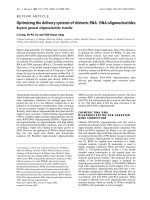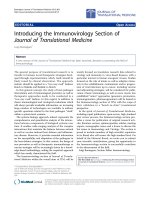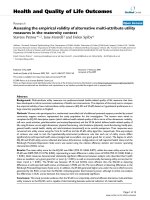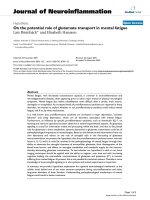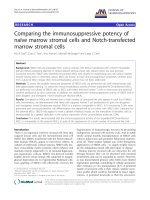báo cáo hóa học:" Optimizing the thermoelectric performance of zigzag and chiral carbon nanotubes" pdf
Bạn đang xem bản rút gọn của tài liệu. Xem và tải ngay bản đầy đủ của tài liệu tại đây (886.89 KB, 18 trang )
This Provisional PDF corresponds to the article as it appeared upon acceptance. Fully formatted
PDF and full text (HTML) versions will be made available soon.
Optimizing the thermoelectric performance of zigzag and chiral carbon
nanotubes
Nanoscale Research Letters 2012, 7:116 doi:10.1186/1556-276X-7-116
Xiaojin Tan ()
Huijin Liu ()
Yanwei Wen ()
Hongyan Lv ()
Lu Pan ()
Jing Shi ()
Xinfeng Tang ()
ISSN 1556-276X
Article type Nano Express
Submission date 5 November 2011
Acceptance date 11 February 2012
Publication date 11 February 2012
Article URL />This peer-reviewed article was published immediately upon acceptance. It can be downloaded,
printed and distributed freely for any purposes (see copyright notice below).
Articles in Nanoscale Research Letters are listed in PubMed and archived at PubMed Central.
For information about publishing your research in Nanoscale Research Letters go to
/>For information about other SpringerOpen publications go to
Nanoscale Research Letters
© 2012 Tan et al. ; licensee Springer.
This is an open access article distributed under the terms of the Creative Commons Attribution License ( />which permits unrestricted use, distribution, and reproduction in any medium, provided the original work is properly cited.
1
Optimizing the thermoelectric performance of zigzag and chiral carbon
nanotubes
Xiaojian Tan
1
, Huijun Liu*
1
, Yanwei Wen
1
, Hongyan Lv
1
, Lu Pan
1
, Jing Shi*
1
, and
Xinfeng Tang
2
1
Key Laboratory of Artificial Micro- and Nano-structures of Ministry of Education and
School of Physics and Technology, Wuhan University, Wuhan, 430072, China
2
State Key Laboratory of Advanced Technology for Materials Synthesis and Processing,
Wuhan University of Technology, Wuhan, 430072, China
*Corresponding authors: ;
Email addresses:
XJT:
HJL:
YWW:
HYL:
LP:
JS:
XFT:
Abstract
Using nonequilibrium molecular dynamics simulations and nonequilibrium Green's
function method, we investigate the thermoelectric properties of a series of zigzag and
chiral carbon nanotubes which exhibit interesting diameter and chirality dependence. Our
calculated results indicate that these carbon nanotubes could have higher ZT values at
appropriate carrier concentration and operating temperature. Moreover, their
thermoelectric performance can be significantly enhanced via isotope substitution,
isoelectronic impurities, and hydrogen adsorption. It is thus reasonable to expect that
carbon nanotubes may be promising candidates for high-performance thermoelectric
materials.
Introduction
As it can directly convert waste heat into electric power, thermoelectric material is
expected to be one of the promising candidates to meet the challenge of energy crisis.
The performance of a thermoelectric material is quantified by the dimensionless figure of
merit
( )
2
e p
S T
ZT
σ
κ κ
=
+
, where
S
is the Seebeck coefficient,
σ
is the electrical
conductivity,
T
is the absolute temperature, and
e
κ
and
p
κ
are the electron- and phonon-
derived thermal conductivities, respectively. An ideal thermoelectric material requires
2
glass-like thermal transport and crystal-like electronic properties [1], i.e., one should try
to improve the ZT value by increasing the power factor [
2
S
σ
] and/or decreasing the
thermal conductivity (
e p
κ κ κ
= +
) at an appropriate temperature. Such a task is usually
very difficult since there is a strong correlation of those transport coefficients according
to the Wiedemann-Franz law [2]. Low-dimensional or nanostructure approaches [3,4],
however, offer new ways to effectively manipulate electron and phonon transports and
thus can significantly improve the ZT value.
As an interesting quasi-one-dimensional nanostructure with many unusual properties,
carbon nanotubes [CNTs] have attracted a lot of attention from the science community
since their discovery [5]. However, few people believe that CNTs could be promising
thermoelectric materials. This is probably due to the fact that although CNTs can have
much higher electrical conductivities, their thermal conductivities are also found to be
very high [6-11].As a result, the ZT values of CNTs predicated from previous works [10,
12] are rather small (approximately 0.0047). Prasheret al. [13] found the so-called ‘CNT
bed’ structure could reduce the thermal conductivity of CNTs. However, the random
network of the samples may weaken the electronic transport, and the room temperature
ZT value is estimated to be 0.2. Jiang et al. [14] investigated the thermoelectric properties
of single-walled CNTs using a nonequilibrium Green's function approach [NEGF]. They
found that CNTs exhibit very favorable electronic transport properties, but the maximum
ZT value is only 0.2 at 300 K. The possible reason is the neglect of nonlinear effect [15]
in the phonon transport, and the corresponding thermal conductivity was overestimated.
If the thermal conductivity can be significantly reduced without many changes to their
electronic transport, CNTs may have very favorable thermoelectric properties. In this
work, we use a combination of nonequilibrium molecular dynamics simulations and
NEGF method to study the thermoelectric properties of a serial of CNTs with different
diameters and chiralities. They are the zigzag (7,0), (8,0), (10,0), (11,0), (13,0), (14,0)
and the chiral (4,2),(5,1), (6,2), (6,4), (8,4), (10,5), and all are semiconductors in their
pristine form. By cooperatively manipulating the electronic and phonon transports, we
shall see that these CNTs could be optimized to exhibit much higher ZT values by isotope
substitution, isoelectronic impurities, and hydrogen adsorption. It is thus reasonable to
expect that CNTs may be promising candidates for high-performance thermoelectric
materials.
Computational details
The phonon transport is studied using the nonequilibrium molecular dynamics [NEMD]
simulations as implemented in the LAMMPS software package (Sandia National
Laboratories, Livermore, CA, USA)[16]. The Tersoff potential [17] is adopted to solve
Newtonian equations of motion according to the Müller-Plathe algorithm [18] with a
fixed time step of 0.5 fs. We carry out a 300-ps constant temperature simulation and a
200-ps constant energy simulation to make sure that the system has reached a steady state.
The nanotubes are then divided into 40 equal segments with periodic boundary condition,
and the first and twenty-first segments are defined as the hot and cold regions,
respectively. The coldest atom in the hot region and the hottest one in the cold region
swap their kinetic energies every hundreds of time steps, and then temperature gradient
3
responses and thermal flux maintain via atom interactions in neighboring segments [19,
20]. The electronic transport is calculated using the NEGF method as implemented in the
AtomistixToolKit code (Quantum Wise A/S, Copenhagen, Denmark) [21, 22]. The
nanotube is modeled by a central part connected by the left and right semi-infinite one.
We use the Troullier-Martins nonlocal pseudopotentials [23] to describe the electron-ion
interactions. The exchange-correlation energy is in the form of PW-91 [24], and the
cutoff energy is set to be 150 Ry. We use a double
ζ
basis set plus polarization for the
carbon atoms, and the Brillouin zone is sampled with 1×1×100 Monkhorst-Pack meshes.
The mixing rate of the electronic Hamiltonian is set as 0.1, and the convergent criterion
for the total energy is 4×10
−5
eV.
Results and discussions
We begin with the phonon transport of these CNTs using the NEMD simulations, where
the phonon-induced thermal conductivity [
p
κ
] is calculated according to Fourier's law
p
( )
J
A T
κ
=
⋅∇
. Here,
J
is the heat flux from the hot to cold region;
A
is the cross-
sectional area of the system, and
T
∇
is the temperature gradient. To test the reliability of
our computational method, in Figure 1, we plot the NEMD-calculated thermal
conductivity of the tube (4,2) as a function of temperature. For comparison, the result
using a more accurate Callaway-Holland model [25, 26] is also shown. We see that the
NEMD result agrees well with that of the Callaway-Holland model when the temperature
is larger than 150 K. As molecular dynamics simulation is much faster than other
approaches and can handle nonlinearity when dealing with heat transport, we will use it
throughout our work as long as the temperature is not very low.
For low-dimensional systems, one should pay special attention to the size effect when
discussing the thermal conductivity. Both the experiment measurements [27, 28] and
molecular dynamics simulations [29, 30] indicate that the
p
κ
of CNTs depends on their
length, which is different from that of bulk materials. Here, we use a simple approach [20]
by calculating the thermal conductivity at different tube lengths and then using a linear
fitting according to the formula
1
p
a b
l
κ
+
=
. Table 1 summarizes the NEMD-calculated
room temperature
p
κ
of a series of zigzag and chiral nanotubes. It should be noted that
we have carried out a quantum correction [31] to the thermal conductivity, and the tube
length is assumed to be 1 µm for all the CNTs considered. As can be seen from the table,
the room temperature
p
κ
of CNTs are indeed very high which range from several
hundreds to more than 1,000 W/m·K. If we focus on the zigzag CNTs, we find that the
thermal conductivity decreases as the tube diameter is increased. This is also the case for
the chiral CNTs with the same chiral angle (e.g., the (4,2), (8,4), and (10,5) tubes). The
reason is that larger diameter CNTs have a smaller average group velocity, and the
probability of the Umklapp process is higher [25, 32]. On the other hand, if we focus on
those CNTs with roughly similar diameters (e.g., (7,0)vs. (6,2),(11,0)vs. (8,4),(13,0)vs.
(10,5)), it is interesting to find that the thermal conductivity of the chiral tube is always
4
lower than that of the zigzag one. As these CNTs have a similar average group velocity,
we believe that the more frequent phonon Umklapp scattering in the chiral tubes makes a
significant contribution to the reduced thermal conductivity.
We now move to the discussions of electronic transport using the NEGF approach. Figure
2 shows the calculated electronic transmission function [
( )
T E
] for the above-mentioned
zigzag and chiral series. Within the rigid-band picture,
0
E
>
corresponds to the n-type
doping, while
0
E
<
corresponds to the p-type doping. Here, we focus on the electron
ballistic transport and ignore the weak electron-phonon scattering. We see that all the
investigated CNTs exhibit quantized transmission which can be essentially derived from
their energy band structures. The vanishing transmission function around the Fermi level
is consistent with the fact that all of them are semiconductors. It is interesting to find that
those CNTs with a larger diameter have a symmetrically distributed transmission function
near the Fermi level. However, this is not the case for the smaller diameter CNTs such
as(7,0), (8,0), and (4,2), where we see that the number of first conduction channel is two
for the p-type doping and one for the n-type doping. By integrating [33] the calculated
( )
T E
, one can easily obtain the Seebeck coefficient (
S
), the electrical conductance [
G
],
and the electronic thermal conductance [
e
λ
] within the linear response limit. Here, we
choose the zigzag (10,0) and chiral (6,4) as two typical examples and plot in Figure 3 the
corresponding transport coefficients at 300 K as a function of chemical potential
[
µ
].Note that the chemical potential indicates the doping level or carrier concentration of
the system, and the n-type doping corresponds to
0
µ
>
,
while p-type corresponds to
0
µ
<
. As can be seen in Figure 3a,b, both
G
and
e
λ
of these two CNTs vanish around
the Fermi level (
0
µ
=
) since this area corresponds to the band gap of the systems. When
the chemical potential moves to the edge of the first conduction channels, there is a sharp
increase of
G
and
e
λ
. For both the (10,0) and (6,4) tubes, the
S
shown in Figure 3c is
rather symmetric about the Fermi level, which can be attributed to the symmetrically
distributed first conduction channels (see Figure 2). The absolute value of the Seebeck
coefficient reaches the maximum value at
B
k T
µ
≈ ± and then decreases until vanish near
the edge of band gap.
It should be mentioned that we have used the term ‘conductivity’ for the phonon transport
but ‘conductance’ for the electronic transport. To avoid arbitrary definition of cross-
sectional area in low-dimensional system such as CNTs, we rewrite the figure of merit as
( )
2
e p
S GT
ZT
λ λ
=
+
, where the phonon-induced thermal conductance (
p
λ
) has been used to
replace the original thermal conductivity(
p
κ
). Figure 3d shows the chemical potential
dependent ZT value at 300 K for the (10,0) and (6,4) tubes. We see that both of them
exhibit two peak values around the Fermi level, which suggest that by appropriate p-type
and n-type doping, one can significantly enhance the thermoelectric performance of
CNTs. For the (10,0) tube, the maximum ZT value is found to be 0.9, and it appears at
0.40 eV
µ
= ±
. In the case of (6,4) tube, the ZT value can be optimized to 1.1 at
5
0.44 eV
µ
= ±
. The same doping level for the p-type and n-type doping in the (10,0) or
(6,4) tubes is very beneficial for their applications in real thermoelectric devices.
Up to now, we are dealing with room temperature, and the corresponding ZT values are
still not comparable to that of the best commercial materials. Moreover, a thermoelectric
material may be needed to operate at different temperatures for different applications. We
thus perform additional transport calculations where the temperature ranges from 250 to
1,000 K. Figure 4 plots the calculated ZT values as a function of temperature for the
above-mentioned zigzag and chiral series. At each temperature, two ZT values are shown
which correspond to the optimized p-type and n-type doping in each tube. Except for the
small (4,2) tube with a maximum ZT value at 300 K, we see in Figure 4 that the
thermoelectric performance of other CNTs can be significantly enhanced at a relatively
higher temperature. The maximum ZT values achieved are 3.5 for the zigzag (10,0) at
800 K and 4.5 for the chiral (6,4) at 900 K. These values are very competitive with that of
conventional refrigerators or generators. It is interesting to note that among the
investigated CNTs, both the (10,0) and (6,4) tubes have an intermediate diameter (0.7 to
approximately 0.8 nm), and those with larger or smaller diameters have a relatively less
favorable thermoelectric performance. On the other hand, we see that almost all the
zigzag tubes exhibit a peak ZT value at an intermediate temperature (700 to
approximately 800 K). In contrast, the peak for the chiral series moves roughly from 300
to 900K as the tube diameter is increased. Our calculated results thus provide a simple
map by which one can efficiently find the best CNT for the thermoelectric applications at
different operating temperatures.
To further improve the thermoelectric performance of these CNTs, we have considered
isotope substitution which is believed to reduce the phonon-induced thermal conductance
without changing the electronic transport properties [34-36]. Here, we choose (10,0) as
an example since it has the highest ZT value among those in the zigzag series, and the
zigzag tubes are usually easier to be fabricated in or to be selected from the experiments
than the chiral ones. In our calculations, the
12
C atoms in the (10,0) tube are randomly
substituted by
13
C atoms at different concentrations. The corresponding lattice thermal
conductance as well as the ZT value at 800K is shown in Figure 5 with respect to the
pristine values. Due to the mass difference between
12
C and
13
C, we see that the
calculated thermal conductance of the (10,0) tube decreases with the increasing
concentration of
13
Catoms. Of course, if half or more
12
Catoms are substituted, the
situation is reversed. The thermal conductance can be well fitted by a double exponential
function
(1 )
p
0.28 0.24
p0
0.36 0.35 0.62
x x
e e
λ
λ
− − −
= + + , where
x
is the concentration of
13
C atoms.
For a light isotope substitution (
12
C
0.95
13
C
0.05
), the thermal conductance is already reduced
by about 9% and the ZT value can be increased to 3.7 from the pristine value of 3.5. If
half
12
C atoms are replaced (
12
C
0.5
13
C
0.5
), the corresponding thermal conductance reaches
the minimum and the ZT value can be as high as 4.2, which suggests its appealing
thermoelectric applications.
Introducing isoelectronic impurities is another effective way to localize phonon and
reduce lattice thermal conductance due to impurity scattering [37]. Here, we choose Si as
6
an example and consider a very low concentration where one C atom in a (10,0) supercell
containing three primitive cells is replaced by a Si atom. The resulting product has a
nominal formula of C
119
Si and is schematically shown in Figure 6a. As the mass
difference between C and Si is even larger, we find that the phonon-derived thermal
conductance of C
119
Si is significantly reduced by 45% to approximately 60% compared
with that of the pristine(10,0) tube in the temperature range from 300 to 900 K. On the
other hand, since C and Si atoms have the same electron configuration, one may expect
that Si doping will not change much of the electronic transport properties. Indeed, our
calculations only find a small weakening of the power factor (
2
S G
). As a result, we see
in Figure 6c that there is an overall increase of the ZT value at the temperature range of
300to 700 K. The Si-doped product has a maximum ZT=4.0 at
600 K
T
=
compared with
the pristine value of 3.5 at
800 K
T
=
. It is worth to mention that in a wide temperature
range (450 to approximately 850 K), the ZT values of the Si-doped product are all higher
than 3.0 which is very beneficial for their thermoelectric applications.
A similar improvement of the thermoelectric performance can be achieved by hydrogen
adsorption on the (10,0) tube. As shown in Figure 6b, two hydrogen atoms are
chemisorbed on top of a C-C bond along the tube axis, and the product has a
concentration of C
40
H
2
. Our calculated results indicate that such hydrogen adsorption
causes deformation of the (10,0) tube and reduces both the phonon- and electron-induced
thermal conductance while keeping the
2
S G
less affected. For example, the calculated
p
λ
at 600 K is 0.072 nW/K, which is much lower than that found for the pristine (10,0) tube
(0.21 nW/K). The calculated
e
λ
also decreases from 0.089to 0.062nW/K. At the same
time, we find that the
2
S G
of the chemisorbed product (9.47×10
−13
W/K
2
) is slightly
lower than that of the pristine (10,0) tube (1.28×10
−12
W/K
2
). As a result, the calculated
ZT value at 600 K increases significantly from 2.6 to 4.2 which is even higher than the
highest value of the pristine (10,0) tube. The chemisorptions of hydrogen also increase
the ZT value at other temperatures, as indicated in Figure 6c. It is interesting to note that
the temperature-dependent behavior almost coincides with that from Si doping, especially
in the temperature region from 400 to 700 K.
Summary
In summary, our theoretical calculations indicate that by appropriate n-type and p-type
doping, one can obtain much higher ZT values for both the zigzag and armchair CNTs,
and those tubes with an intermediate diameter (approximately 0.7 to 0.8 nm) seems to
have better thermoelectric properties than others. With the zigzag (10,0) as an example,
we show that the phonon-induced thermal conductance can be effectively reduced by
isotope substitution, isoelectronic impurities, and hydrogen adsorption, while the
electronic transport is less affected. As a result, the ZT value can be further enhanced and
is very competitive with that of the best commercial materials. To experimentally realize
this goal, one needs to fabricate CNTs with specific diameter and chirality, and the tube
length should be at least 1 µm. This may be challenging but very possible, considering
the fact that the (10,0) tube was successfully produced by many means, such as by direct
laser vaporization [38], electric arc technique [39], and chemical vapor deposition [40],
7
and can be selected from mixed or disordered samples using a DNA-based separation
process [41].
Competing interests
The authors declare that they have no competing interests.
Authors’ contributions
XJT carried out the NEGF and NEMD calculations. HJL participated in the design of the
study and discussions of the theoretical results. YWW, HYL, and LP participated in the
implementation of the LAMMPS and ATK codes. JS and XFT participated in the
discussions of related experimental works. All authors read and approved the final
manuscript.
Acknowledgments
This work was supported by the ‘973 Program’ of China (grant no. 2007CB607501), the
National Natural Science Foundation (grant no. 51172167), and the Program for New
Century Excellent Talents in the University. We also acknowledge the financial support
from the inter-discipline and postgraduate programs under the ‘Fundamental Research
Funds for the Central Universities’. All the calculations were performed in the PC Cluster
from Sugon Company of China.
References
1. Slack GA: New materials and performance limits for thermoelectric cooling.
In CRC Handbook of Thermoelectrics. Edited by Rowe DM. Boca Raton: CRC
Press; 1995:407.
2. Bejan A, Allan, AD: Heat Transfer Handbook. New York: Wiley; 2003.
3. Hicks LD, Dresselhaus, MS: Effect of quantum-well structures on the
thermoelectric figure of merit. Phys Rev B 1993, 47:12727-12731.
4. Hicks LD, Dresselhaus, MS: Thermoelectric figure of merit of a one-
dimensional conductor. Phys Rev B 1993, 47:16631-16634.
5. Iijima S: Helical microtubules of graphitic carbon. Nature 1991, 354:56-58.
8
6. Hone J, Whitney M, Piskoti C, Zettl A: Thermal conductivity of single-walled
carbon nanotubes. Phys Rev B 1999, 59:R2514-R2516.
7. Hone J, Llaguno MC, Nemes NM, Johnson AT, Fischer JE, Walters DA,
Casavant MJ, Schmidt J, Smalley RE: Electrical and thermal transport
properties of magnetically aligned single wall carbon nanotube films. Appl
Phys Lett 2000, 77:666-668.
8. Berber S, Kwon YK, Tomanek D: Unusually high thermal conductivity of
carbon nanotubes. Phys Rev Lett 2000, 84:4613-4616.
9. Kim P, Shi L, Majumdar A, McEuen PL: Thermal transport measurements of
individual multiwalled nanotubes. Phys Rev Lett 2001, 87:215502.
10. Yu C, Shi L, Yao Z, Li D, Majumdar A: Thermal conductance and
thermopower of an individual single-wall carbon nanotube. Nano Lett 2005,
5:1842-1846.
11. Pop E, Mann D, Cao J, Wang Q, Goodson K, Dai H: Negative differential
conductance and hot phonons in suspended nanotube molecular wires. Phys
Rev Lett 2005, 95:155505.
12. Purewal MS, Hong BH, Ravi A, Chandra B, Hone J, Kim P: Scaling of
resistance and electron mean free path of single-walled carbon nanotubes.
Phys Rev Lett 2007, 98:186808.
13. Prasher RS, Hu XJ, Chalopin Y, Mingo N, Lofgreen K, Volz S, Cleri F, Keblinski
P: Turning carbon nanotubes from exceptional heat conductors into
insulators. Phys Rev Lett 2009, 102:105901.
14. Jiang JW, Wang JS, Li BW: A nonequilibrium green’s function study of
thermoelectric properties in single-walled carbon nanotubes. J Appl Phys
2011, 109:014326.
15. Wang JS, Wang J, Zeng N: Nonequilibrium Green’s function approach to
mesoscopic thermal transport. Phys Rev B 2006, 74:033408.
16. Plimpton S: Fast parallel algorithms for short-range molecular dynamics. J
Comput Phys 1995, 117:1-19.
17. Tersoff J: Modeling solid-state chemistry: interatomic potentials for
multicomponent systems. Phys Rev B 1989, 39:5566-5568.
18. Müller-Plathe F: A simple nonequilibrium molecular dynamics method for
calculating the thermal conductivity. J Chem Phys 1997, 106:6082.
9
19. Osman MA, Srivastava D: Temperature dependence of the thermal
conductivity of single-wall carbon nanotubes. Nanotechnology 2001, 12:21-24.
20. Schelling PK, Phillpot SR, Keblinski P: Comparison of atomic-level simulation
methods for computing thermal conductivity. Phys Rev B 2002, 65:144306.
21. Brandbyge M, Mozos JL, Ordejόn P, Taylor J, Stokbro K: Density-functional
method for nonequilibrium electron transport. Phys Rev B 2002, 65:1-17.
22. Soler JM, Artacho E, Gale JD, García A, Junquera J, Ordejόn P, Sánchez-Portal
D: The SIESTA method for ab initio order-N materials simulation. J Phys:
Conders. Matter 2002, 14:2745-2779.
23. Troullier N, Martins JL: Efficient pseudopotentials for plane-wave
calculations. II. Operators for fast iterative diagonalization. Phys Rev B1991,
43:8861-8869.
24. Perdew JP, Wang Y: Accurate and simple analytic representation of the
electron-gas correlation energy. Phys Rev B 1992, 45:13244-13249.
25. Cao JX, Yan XH, Xiao Y, Ding JW: Thermal conductivity of zigzag single-
walled carbon nanotubes: role of the umklapp process. Phys Rev B 2004, 69:4-
7.
26. Gu Y, Chen Y: Thermal conductivities of single-walled carbon nanotubes
calculated from the complete phonon dispersion relations. Phys Rev B 2007,
76:1-9.
27. Wang ZL, Tang DW, Li XB, Zheng XH, Zhang WG, Zheng LX, Zhu YT, Jin AZ,
Yang HF, Gu CZ: Length-dependent thermal conductivity of an individual
single-wall carbon nanotubes. Appl Phys Lett 2007, 91:123119.
28. Chang CW, Okawa D, Garcia H, Majumdar A, Zettl A: Breakdown of Fourier’s
law in nanotube thermal conductors. Phys Rev Lett 2008, 101:075903.
29. Che J, Çağın T, Goddard WA III: Thermal conductivity of carbon nanotubes.
Nanotechnology 2000, 11:65-69.
30. Padgett CW, Brenner DW: Influence of chemisorption on the thermal
conductivity of single-wall carbon nanotubes. Nano Lett 2004, 4:1051-1053.
31. Maiti A, Mahan GD, Pantelides ST: Dynamical simulations of nonequilibrium
processes - heat flow and the Kapitza resistance across grain boundaries.
Solid State Commun 1997, 102:517-521.
10
32. Cao JX, Yan XH, Xiao Y, Ding JW: Exact study of lattice dynamics of single-
walled carbon nanotubes. Phys Rev B 2003, 67:045413.
33. Esfarjani K, Zebarjadi M, Kawazoe Y: Thermoelectric properties of a
nanocontact made of two-capped single-wall carbon nanotubes calculated
within the tight-binding approximation. Phys Rev B 2006, 73:085406.
34. Zhang G, Li B: Thermal conductivity of nanotubes revisited: effects of
Chirality, Isotope impurity, tube length, and temperature. J Chem Phys 2005,
123:114714.
35. Chang CW, Fennimore AM, Afanasiev A, Okawa D, Ikuno T, Garcia H, Li D,
Majumdar A, Zettl A: Isotope effect on the thermal conductivity of boron
nitride nanotubes. Phys Rev Lett 2006, 97:085901.
36. Balasubramanian G, Puri IK, Böhm MC, Leroy F: Thermal conductivity
reduction through isotope substitution in nanomaterials: predictions from an
analytical classical model and nonequilibrium molecular dynamics
simulations. Nanoscale 2011, 3:3714-3720.
37. Chen J, Zhang G, Li B: Tunable thermal conductivity of Si
1−x
Ge
x
nanowires.
Appl Phys Lett 2009, 95:073117.
38. Guo T, Nikolaev P, Thess A, Colbert DT, Smalley RE: Catalytic growth of
single-walled nanotubes by laser vaporization. Chem Phys Lett 1995, 243:49-
54.
39. Journet C, Maser WK, Bernier P, Loiseau A, Chapelle ML, Lefrant S, Deniard P,
Leek R, Fischer JE: Large-scale production of single-walled carbon nanotubes
by the electric-arc technique. Nature 1997, 388:756-758.
40. Kong J, Soh HT, Cassell AM, Quate CF, Dai H: Synthesis of individual single-
walled carbon nanotubes on patterned silicon wafers. Nature 1998, 395:878-
881.
41. Zheng M, Jagota A, Semke ED, Diner BA, Mclean RS, Lustig SR, Richardson
RE, Tassi NG: DNA-assisted dispersion and separation of carbon nanotubes.
Nat Mater 2003, 2:338-342.
Figure 1. Lattice thermal conductivity of tube (4,2) as a function of temperature.
Results from the Callaway-Holland model and the nonequilibrium molecular dynamics
simulations are both shown.
11
Figure 2. Calculated electron transmission function for a series of (a) zigzag and (b)
chiral tubes.
Figure 3. Calculated transport coefficients at 300 K as a function of chemical
potential. These are for zigzag (10,0) and chiral (6,4). (a) Electric conductance, (b)
electronic thermal conductance, and (c) Seebeck coefficient with (d) the corresponding
ZT values.
Figure 4. Optimized ZT values as a function of temperature. These are for a series of
(a) zigzag and (b) chiral tubes. The results for the p-type and n-type doping are both
shown.
Figure 5. Lattice thermal conductance and the ZT value. Calculated lattice thermal
conductance (red) and optimized ZT value (blue) at 800 K for the (10,0) tube, where the
12
C atoms are substituted by
13
C atoms with different concentrations. Note that the results
are given with respect to those of the pure
12
C tube.
Figure 6. Fully relaxed structures and optimized ZT values of CNTs. Top view of the
fully relaxed structures for (a) Si-doped (10,0) tube with nominal formula of C
119
Si and
(b) the (10,0) tube chemisorbed with hydrogen atoms having nominal formula of C
40
H
2
.
(c) Plots of the optimized ZT value as a function of temperature for theC
119
Si and C
40
H
2
products, and the results for the pristine (10,0) tube is also shown for comparison.
Table 1. Summary of the NEMD-calculated room temperature
p
κ
of a series of
zigzag and chiral nanotubes
Tubes d (nm) θ (°) κ
p
(W/m·K)
(7,0) 0.548 0 1270
(8,0) 0.627 0 955
(10,0) 0.783 0 809
(11,0) 0.862 0 778
(13,0) 1.019 0 613
Zigzag
(14,0) 1.097 0 599
(4,2) 0.414 19.2 1337
(5,1) 0.436 8.9 1413
(6,2) 0.565 13.9 1009
(6,4) 0.683 23.4 829
(8,4) 0.829 19.2 721
Chiral
(10,5) 1.036 19.2 564
The corresponding tube diameter (d) and chiral angle (
θ
) are also given.
Figure 1
Figure 2
Figure 3
Figure 4
Figure 5
Figure 6
